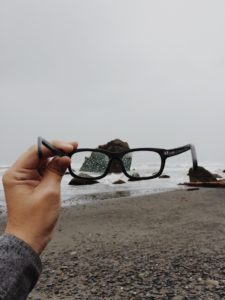 To see clearly, the cornea and the lens must bend, (refract) light rays so they focus on the retina. The retina is a layer of light-sensing cells that line the back of the eye. These cells convert the light rays into impulses that are sent to the brain where they are recognized as images. If the light rays don’t focus properly on the retina, the image you see is blurry. This is called a refractive error. Glasses, contact lenses and refractive surgery such as LASIK try to reduce these errors by making light rays focus on the retina.
To see clearly, the cornea and the lens must bend, (refract) light rays so they focus on the retina. The retina is a layer of light-sensing cells that line the back of the eye. These cells convert the light rays into impulses that are sent to the brain where they are recognized as images. If the light rays don’t focus properly on the retina, the image you see is blurry. This is called a refractive error. Glasses, contact lenses and refractive surgery such as LASIK try to reduce these errors by making light rays focus on the retina.
Refractive errors are caused by an imperfectly shaped eyeball, cornea or lens — or in the case of presbyopia, a lens that can’t change shape enough to focus on close objects. The most common type of refractive error is myopia, also known as nearsightedness, a condition where only nearby objects are clear or distinct. Nearsightedness causes patients to have difficulty seeing things that are far away. Because a nearsighted eye is longer than a normal eye, light passing through the cornea gets focused in front of the retina instead of on it. LASIK surgery can correct this condition by reshaping the steep cornea so that light will pass through and be focused at the correct angle on the retina.
Before you sign up for LASIK surgery to correct nearsightedness, here are a few things to think about:
- LASIK is surgery to a very delicate part of your eye and cannot be reversed.
- As with any surgery, there are risks and possible complications.
- Millions of people have had LASIK, many very successfully, but it’s not for everyone.
- LASIK may not give you perfect vision. Most patients achieve somewhere between 20/20 and 20/40 vision, but 20/40 vision may not be sharp enough for certain work or leisure activities. Even 20/20 does not always mean perfect vision. Detailed, precise vision may be slightly diminished.
- If you are nearsighted and don’t yet need reading glasses, having LASIK may mean you will need reading glasses earlier than if you had not had the surgery.
- The benefits of the LASIK procedure may diminish over time. More than 10% of LASIK patients in the U.S. require a second surgery, called an enhancement, to restore the desired vision correction. This is more likely for people who were more nearsighted or farsighted or had higher astigmatism before LASIK.
- Most insurance plans don’t cover the surgery.
To learn more about how LASIK can correct your refractive error and improve your vision, contact Harvard Eye Associates at 949-951-2020 or harvardeye.com to schedule a consultation and exam.








